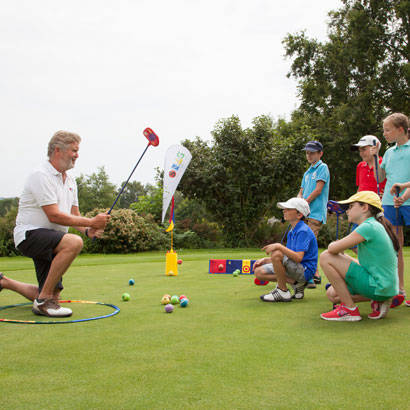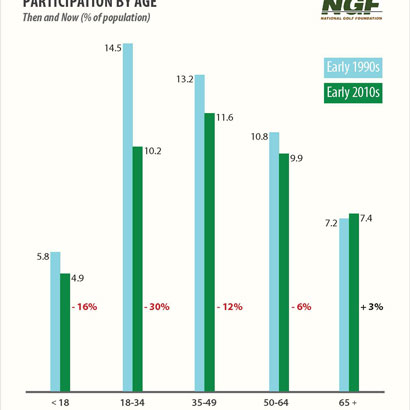
In today’s ESPN world, a child choses his or her sports by age 8, 9 or 10. If we don’t introduce golf before then, we will simply lose them to other sports. We have to get into the parks where the kids and parents are. —Jack Nicklaus
How could one of the most storied and historic sports in the world suddenly be out of favor and heading toward collapse? By some accounts, the statistics show that golf participation is down 20–30 percent from the high-water mark of slightly more than 30 million players to somewhere near 20–23 million current active golfers today. This decrease in participation is across all ages, with the exception of seniors; however, it is especially evident in the 34-and-younger age groups (see chart below).

The world of sports is changing. Not the sports themselves, but how we are introduced to them, fall in love with them and what dynamic allows us to participate in them. Virtually every sport in the world — except golf — follows the three steps below.
- Teach the Sport to ALL in School P.E. Classes Grades K-12
- Use Parks for Age– & Skill–Specific Leagues for All
- Cultivate Top Players Who “Graduate” to Full-Sized Competition
Golf skips No. 1 and No. 2 and tries to go directly to No. 3 on the golf course, and the statistics show that this method is failing. Golf great Jack Nicklaus knows a thing or two about both golf and kids. He has 22 grandkids who all play sports, but only two play golf. They were all introduced to sports in P.E. and park leagues and that is how they fell in love with other sports instead of golf.
Golf is an industry that MUST step into the organized sport arena. Thirty-five million kids (ages 5–18) play an organized sport — 85 percent of them are coached by a dad or mom. If you look at the huge drop of “golfers under 34 years old” statistic, it means that we have currently lost a generation in the golfing population. Furthermore, those new parents who are under 34 years old and do not golf are not going to suddenly start teaching their kids to golf. Instead, they will teach and coach their children to play soccer, baseball, lacrosse, tennis or similar sports that they themselves played as youngsters in their neighborhood parks. And, the game will likely lose another generation.
So, how are we going to introduce golf to our youth? By adapting it like every other sport and putting it in school P.E. classes and moving it into neighborhood park little leagues (with the shirts, hats, snacks and the usual paraphernalia), which then matriculates young golfers and families with skills and passion onto actual golf course play. It is imperative that we re-start the cycle of introduction to golf and learning how to play golf by using today’s methods of organized sports.
We all know we cannot safely tee up a Titleist in a school gymnasium or even a public park — fun perhaps, but inherently dangerous. So, just like baseball has T-ball and soccer has smaller balls and tiny goals, golf can be adapted. And, there already is a modified, adapted version being used today to teach kids the basics of golf in a safe and educationally certified method, indoors or out. It is called SNAG (Starting New At Golf).
SNAG, designed by three educational Ph.D.s and an ex-PGA Tour player, is a great first-touch and developmentally sound method to safely teach golf to beginners. Golfers, PGA pros, First Tee and entire PGA Sections, such as the Midwest PGA’s SNAG-A School programs, are seeing results with it, and it’s already in more than 10,000 schools and 42 countries worldwide. No special fields are required as any open space like a gym, soccer field or park is perfect to play and practice SNAG. The above ground target or “Flagsticky” and the tennis-like ball have Velcro on them so the ball sticks to the target. The ball is always teed-up on a rubber pad so there is no agronomic or floor damage. Full swing, the ball will travel around 35–50 yards, a chip and a putt and it’s off to the next hole.
Times have changed, and the game of golf needs to follow what every other sport does to grow their players and adapt the sport to the children. We are not going to get Millennials to suddenly start golfing; however, we can get to the Millennials’ kids, and those kids will bring the parents in just like they did with soccer moms. With the proper management and a change in the paradigm of how we introduce golf at a young age, we can and will grow more golfers in the future.
John R. Johnson is Vice President of SNAG Player Development.

